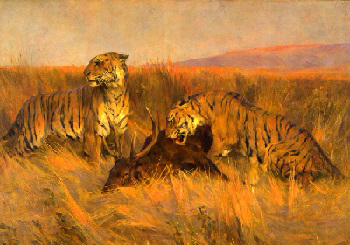Arthur Wardle (British, 1864–1949)
Tigers at Kill
Oil on canvas, 26 x 38 1/4 in.
Signed lower left: ARTHUR WARDLE
DM1869

Largely self-taught, Wardle was regarded as one of England’s most highly accomplished animal painters of his time. Born in London in 1864, Wardle made his debut at the Royal Academy at age 16 and soon found success with his large mythological scenes of women with animals. In 1891 his focus shifted to almost exclusively depicting wildlife, marked by the display of his first major work on this theme, Panthers Resting (location unknown). Wardle’s animal works, particularly those of canines and horses, won him popular approval and between 1880 and 1938 he displayed some 113 paintings at the Royal Academy, while also showing work at the Tooth Gallery in both Paris and New York City, and at the Fine Arts Society in London. He also worked mostly in pastels and watercolors, and was elected to both the Pastel Society (1911) and the Royal Society of Painters in Watercolors (1922).
In Tigers at Kill, Wardle shows two tigers enjoying the spoils of their hunt in a savannah that radiates energy. Animal painting was already a broad genre by the time Wardle began working, but generally speaking Victorian animaliers, such as the British artist Edwin Landseer, painted their works in a tight, academic style. Wardle, on the other hand—who chose to return his exotic subjects to their native homes— rendered them in a naturalistic style, evident here in the quick brushstrokes he used on the grass. These choices distinguished Wardle from his peers, indeed one critic for the Figaro Illustré, Roger Milés, praised Wardle for presenting animals “in picturesque settings” that contained all the “characteristics of race peculiar to them.”


